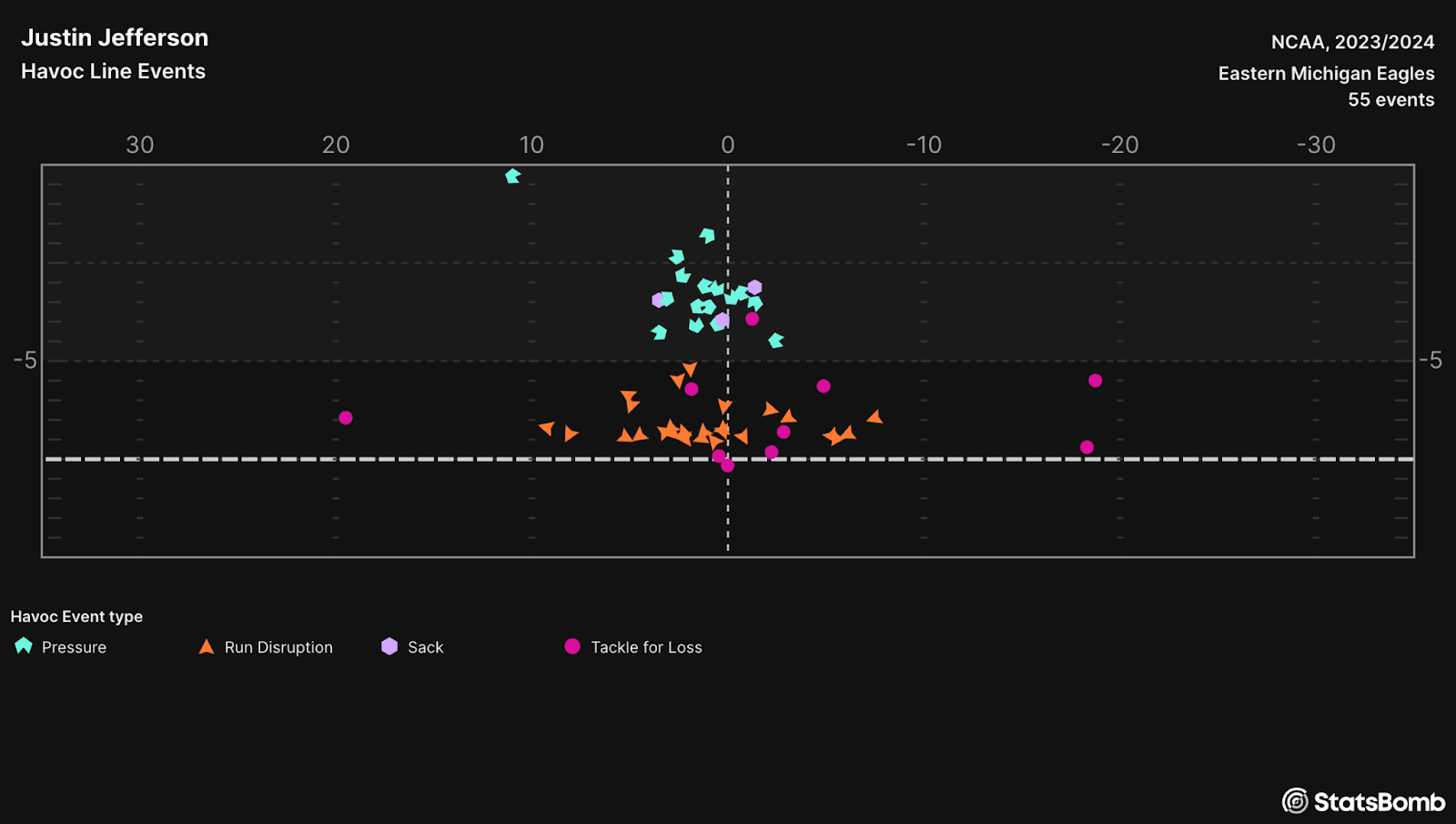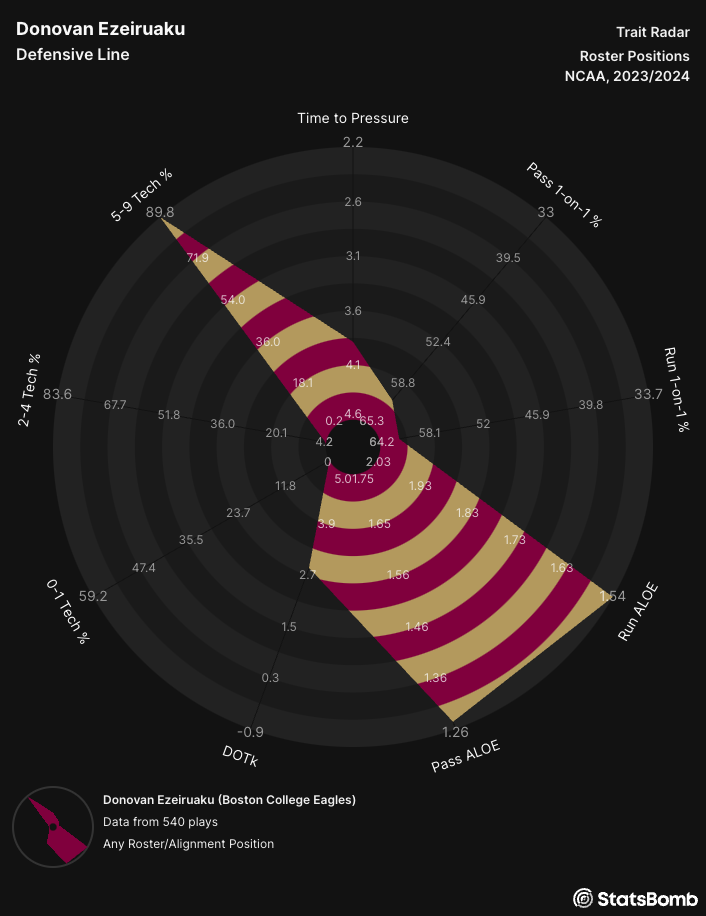NOTE: Following Hudl’s acquisition of Statsbomb, its football platform is now called Hudl IQ. Learn more about the acquisition here.
I hate playing defense on EA College Football 25. I have never really enjoyed it on any of the previous versions, but this version seems especially bad. I hate defense so much that for my dynasty I started as an OC and only play when my team is on offense. When I do have to play defense however (online dynasty is NOT going to be friendly to me), there is only one position I play: Edge Defender.
The base rush on EA College Football 25 is the speed rush. Once you get comfortable with this you can work in different moves like a spin or swim move, but the essence of the rush is speed. This holds true in non-video game football as well, the speed rush is the building block of a pass rusher. If an edge defender has an effective speed rush, the tackle has to get back into his set fast or he will be out of position. If the tackle doesn’t set fast or far enough, the defender can beat him with speed. If the tackle does get into position, a pass rush move might be needed to beat the tackle.
One of the contextual physical metrics we track at Hudl IQ is get-off distance. This is defined as the distance a defender gets upfield in the first second after the snap during a true pass-rush scenario. A pass rush scenario is a 3rd or 4th down and 6 or more yards to go. This definition allows us to isolate when a defender is truly “pinning his ears back” and rushing.
This data returns many different values including the top overall get-off distance, average rush % (how often a player is above the national average), or elite get-off % (how often they have a get-off that is 90th percentile or higher). For this article, I am using the elite get-off percentage because it gives us a good view of not only how good a rusher is, but how repeatable their rush is. Some of the top players from last season have since moved on to the NFL: Dallas Turner, Jared Verse, Chop Robinson, and Laiatu Latu. But there are some exciting players to watch this season (or to use in EA College Football 25 for those afraid of the defensive side of the ball!).
1. James Pearce Jr. (Tennessee) - 53%
One major reason Pearce is an early projected number 1 overall pick for the 2025 draft is his elite get-off. Pearce tied for the nation's lead last year with a rate of elite get-offs over 50%. His average get-off distance was 3.3 yards which was also tied for number 1.
Whether by sheer speed of rush, or something else Tennessee was doing defensively, Pearce had one of the highest one-on-one rush percentages in the country for Edge defenders last season. If teams are hopeful to slow him down, they might want to start double-teaming him and making him do something other than pinning his ears back and heading straight for the QB. It also sounds like I might have a new favorite defensive player for a future dynasty.
2. Stephen Daley (Kent State) - 46%
Kent State was one of the main teams used for the sickos in dynasty mode in 2014 (they were the lowest rated team). They fare a little better this season at a 74 overall and Stephen Daley is a big reason why. Daley is the highest rated player for the Golden Flashes, and our get-off numbers do not disagree. With a 46% elite get-off %, Stephen Daley has the highest returning % in the G5.
One of the concerning things for Daley (and maybe one of the reasons Kent State was able to keep a player with his athleticism) is his ability to translate his explosive get-off into production. Last season he ended up with just 1.5 sacks, and 12 pressures. Daley will have his work cut out for him again this year as Kent State plays Pitt, Penn State, and Tennessee in their out of conference matchups. The September 14th matchup with Tennessee will pit Daley against James Pearve Jr. in a battle for get-off supremacy.
3. Jah Joyner (Minnesota) - 44%
Jah Joyner recently came out and said he wants to be the first Minnesota player in over 15 years to account for double digit sacks. He ended last season with 7.5 sacks and has his sights set on grabbing a few more. Last year Joyner led the Big 10 in pressures and tied for 3rd in sacks. He is set to have another big season this year and should compete to be one of the top Edge defenders in the Big 10, and the country, again this year.
4. Princely Umanmielen (Florida -> Ole Miss) - 44%
Ole Miss loaded up in the transfer portal this year and Princely and fellow DL Walter Nolen were the prize pickups for Lane Kiffin and crew. Princely has the 4th highest returning elite get-off for all Edge defenders and Ole Miss hopes Princely can help bolster a pass rush that doesn’t return anyone that had higher than a 5% elite get-off %.
Side note, Princely was James Pearce’s top comparison from last season when purely looking at production. Sadly in one of those weird conference quirks, Tennessee and Ole Miss haven’t played in 10 years, so we will miss out on another matchup of top Edge returners.

5. Justin Jefferson (EMU) - 43%
If the Vikings Justin Jefferson played Edge defender I bet he would be high on this list. This Justin Jefferson however is not one of the top WR in the NFL, but a G5 defender with a great first step. He also combines his elite get offs with a good average rate. His average get-off rate was 2nd in the country last season at 88%. Many defenders that have elite get-offs are purely pass rush specialists, but Jefferson also plays well against the run. His havoc chart below shows a good mix of run and pass havoc plays.

6. Patrick Payton (Florida State) - 43%
Last year Florida State produced 2 defensive line picks in the first 2 rounds of the NFL draft. Payton’s pass rushing counterpart Jared Verse was the third Edge defender taken in the first round and the Rams paired him with Braden Fiske in the 2nd round. Payton actually had a higher Elite get-off % than Verse last year, and if he keeps that up this season, FSU could make it back to back 1st round DL in the Draft.
7. Joseph Zelinsky (EMU) - 40%
here must be something in the water in Ypsilanti as Zelinsky joins fellow Eagle Jefferson on this list. Zelinsky had one of the fewest qualifying rushes to make the list, but showed off his get-off when he had the chance. Last season, his get-offs didn’t translate to finishing his rushes as he ended the season with only 2 sacks. Zelinsky had more success in the run game though, and was one of the top run disruptors at Edge in the MAC last season. Between Zelinsky and Jefferson, EMU is making a strong case for me in a future dynasty.
8. Donovan Ezeiruaku (BC) - 40%
Of all the rushers on this list, Ezeiruaku has the lowest pressure to sack ratio on here (and not in the good QB way). Ezeiruaku finished the year with just .5 sacks. An effective pass rush can be split into three areas (if you haven’t read this article yet, give it a read) and a get-off is just one part. Ezeiruaku has the first part down pat and from his radar, he has one of the lowest pass ALOE’s in the country as well. These are the two parts that a defender “has control” over. I expect to see more pressures and sacks from Ezeiruaku this season

9. Dani Dennis-Sutton (Penn State) - 39%
Dani Dennis-Sutton is one of the most interesting names on this list, and one that many probably haven’t heard of. Penn State was one of the best defenses in the country last year at getting after the QB. Chop Robinson was a first round pick, and Adisa Isaac was a third round pick. They just moved Abdul Carter from LB to DE in hopes of having another Micah Parsons like result. With all of these big name defenders it is easy to see how Dani Dennis-Sutton could be overlooked. At the end of the season, Dennis-Sutton will be a name on everybody's radar.
10. Tramel Logan (USF -> Louisville) - 39%
Our second transfer on the list, Logan moved up a level from USF to Louisville. Last year his Elite get-off % was just under 40%. Similar to some of the other players on this list, he was missing the next steps of a pass rush as he finished with only 1 sack. Louisville pairs Logan with All-ACC rusher Ashton Gillotte in hopes of putting together a scary pass rushing combo. Gillotte led the ACC in pressures and sacks last season. With a lot of attention paid to Gillotte, Logan should have the chance to turn his excellent get-off into more sacks this season.
I’m excited to see which of these players have the right acceleration numbers on EA College Football, but even more excited to see them actually on the field this fall. This is the first in a series of articles previewing the top 10 returning players in college football utilizing the Hudl IQ physical metrics, with the next one being WR deep-route speed. Stay tuned!
Matt Edwards
Head of American Football Analysis
matt.edwards@statsbomb.com
@thecoachedwards on X (Formerly Twitter)

